I’ve met people who don’t like the tart skin of some plums, and I’ve met people who find apricots mushy, but I’m still waiting to meet the person who has eaten a homegrown pluot and doesn’t ask for more. Just this week I shared some from my trees with a friend who has an abundant and diverse orchard of his own, and later that day I get this text: “Did you sell all your pluots? I want to buy a few more if you will sell a box.”
Pluots are that good.
This post is about my experience growing pluots in Southern California, sprinkled with observations of, and reports about, others’ local pluot trees.
What is a pluot?
Plums and apricots are said to have cross-pollinated in nature for centuries, and Luther Burbank, the famous plant breeder of Northern California, deliberately crossed plums and apricots to make what he called plumcots, which are half plum and half apricot.
But pluots are plum-apricot hybrids that are more plum than apricot. This is accomplished by “backcrossing” a plumcot with a plum. Now you’ve got a fruit that is three quarters plum and one quarter apricot.
There are many other complex “interspecific” hybrids, such as apriums, nectaplums, peacotums, and pluerries — where will it end? Yet, all of them are created through traditional plant breeding methods where one takes pollen from the flower of one tree and puts it on the flower of another tree. There’s no newfangled genetic engineering happening in labs here.
The pluots we have today are products of the breeding efforts of another California man, a man who is still alive and innovating, named Floyd Zaiger. (See an interview with Zaiger, his family, and watch some fruit breeding in action here.)
(Update: Floyd Zaiger passed away on June 2, 2020. See my post, “Thank you, Floyd Zaiger.”)
Pluot varieties
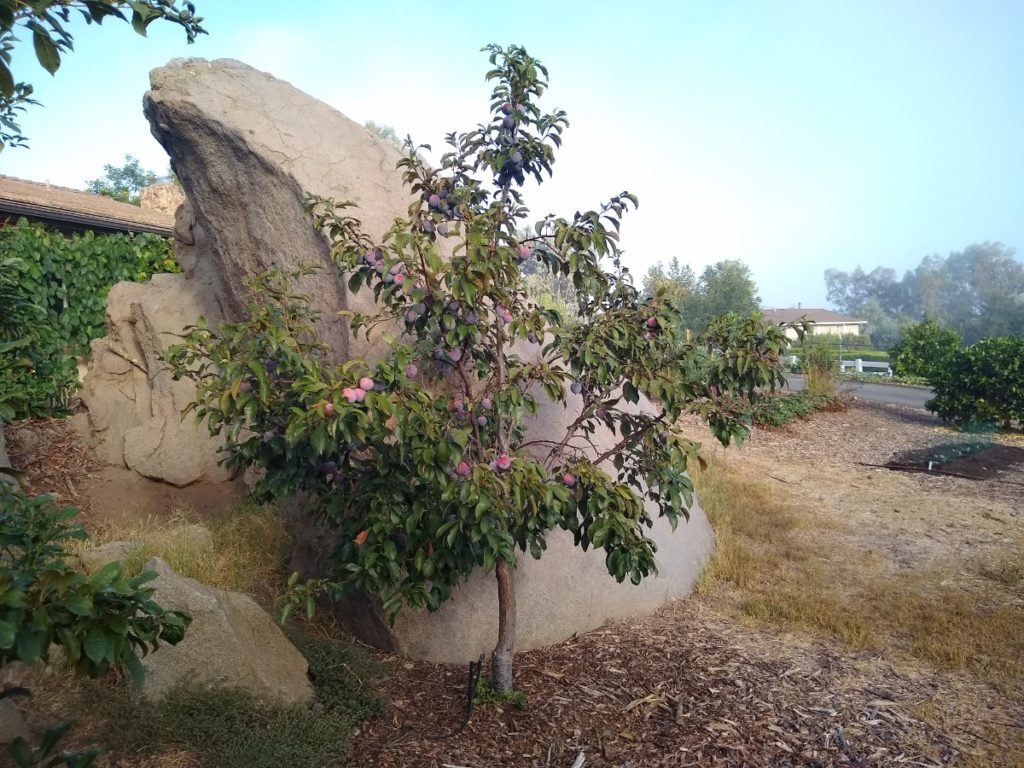
Pluot trees look like plum trees, and pluot fruits look like slightly odd plums, but Floyd Zaiger has been at it so long that the array of pluot varieties now growing around the world come in every shape and color imaginable. Among only the four pluot varieties that I grow in my yard, there is one purple fruit, one red dappled with yellow, one orange, and one green. They can be shaped like balls or hearts or grenades.
While I have tasted dozens of pluot varieties, the only ones that I will make brief comments on are those four that I grow in my yard. I encourage those of you who grow pluots to share your experience with other varieties in the comments section.
Flavor Grenade
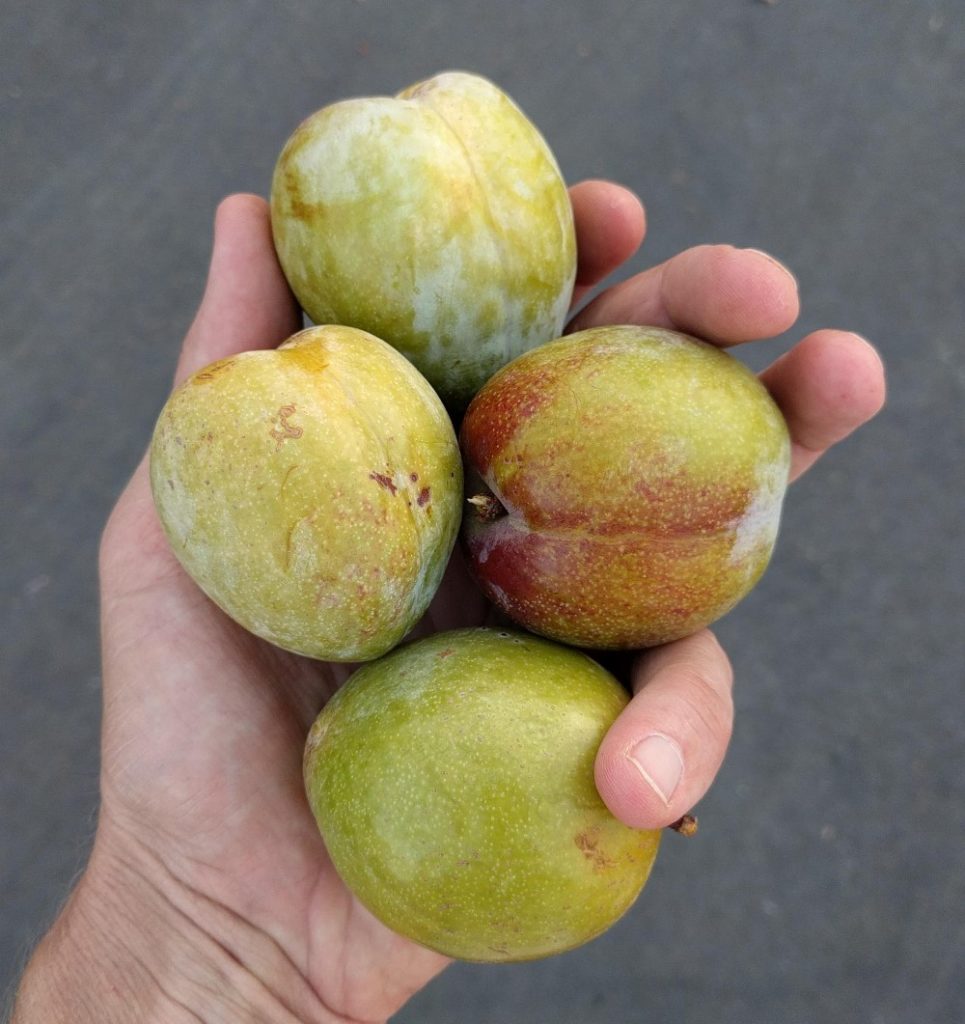
This is the crunchiest pluot I’ve ever had — but to top it off, the crisp texture remains even as the taste reaches extreme sweetness. Those two never coincide! Only in Flavor Grenade.
My brother, who grows many pluots, ranks Flavor Grenade as his favorite.
Splash
This is my orange one, and it is the first of mine to ripen, in July. If picked on the early side, Splash has a tang that reminds me of tangerine.
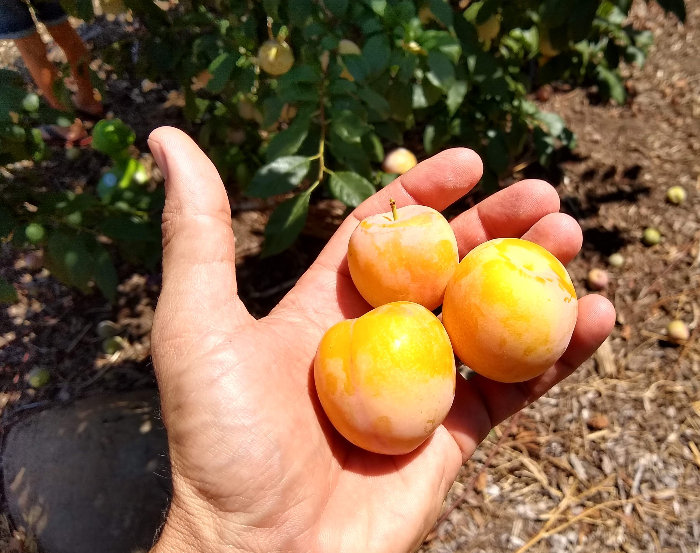
Geo Pride and Emerald Drop
After Splash ripens, Geo Pride and then Emerald Drop start around late July.
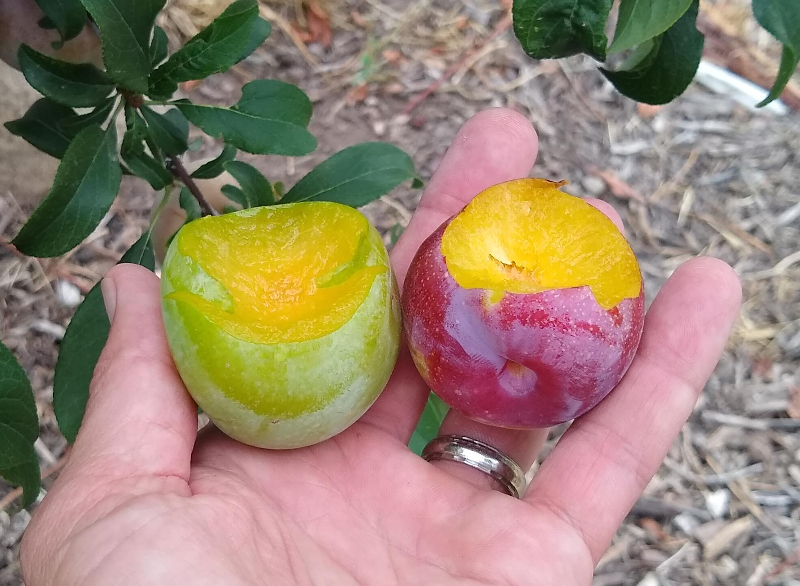
Dapple Dandy
On the tree, the Dapple Dandy fruit look gray as they are covered in their natural waxy “bloom”. They look, honestly, unappealing, which makes the flesh inside that much more surprising. It is a starburst of white and red. It is also juicy and very sweet — less sweet than Flavor Grenade, but sweeter than Flavor King.
Flavor King
There has been a day when each of my pluots has been my favorite, but lately Flavor King has owned more of those days. They’re easy to eat since they’re small and the flesh comes off the stone relatively cleanly. And Flavor King has a taste that I can’t put a word on, but . . .
Watch me try in this short video I made profiling the Flavor King and Dapple Dandy pluot fruits as well as trees:
Harvest seasons and hang time
Because there are so many varieties of pluots, you can grow one that will be ready to eat at the beginning of summer or way off the tail end. Just with our four varieties, the family eats pluots continuously from July through September.
See this harvest chart made by Dave Wilson Nursery, the propagator of Floyd Zaiger’s pluots, which shows the expansive harvest season of pluots: from the end of May into October. And also notice that some individual pluot varieties have long harvest windows.
It amazes me how long pluots hang compared to, say, peaches. Just this year, for example, we started eating Dapple Dandy pluots in mid-August and here in mid-September much of the fruit left on the tree is still at peak flavor. That’s a month of excellent fruit from one variety.
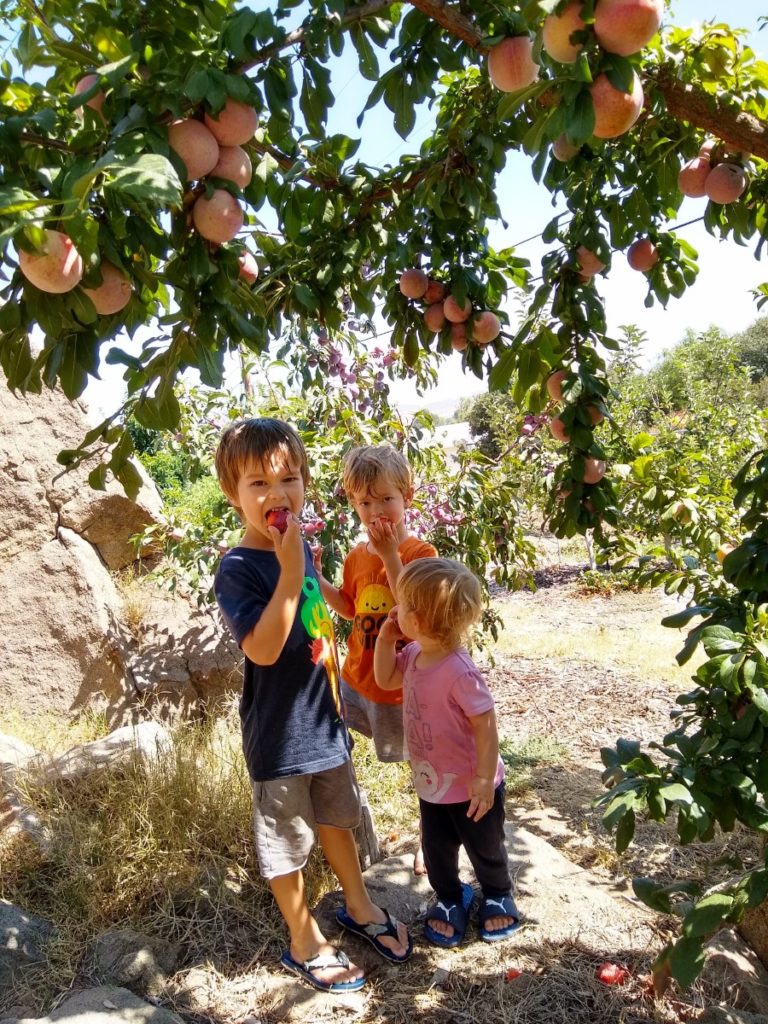
Pollenizer requirements
There are two characteristics of pluots that might make them challenging for you to grow in your yard. One is that they require another pluot or plum for pollination. You can’t just grow one pluot tree.
There are two main ways to meet this challenge. First, you can plant two trees (of the right varieties). You can even plant them very close to each other. I planted a Flavor Grenade pluot eight feet away from a Burgundy plum in my mom’s backyard, shown below.
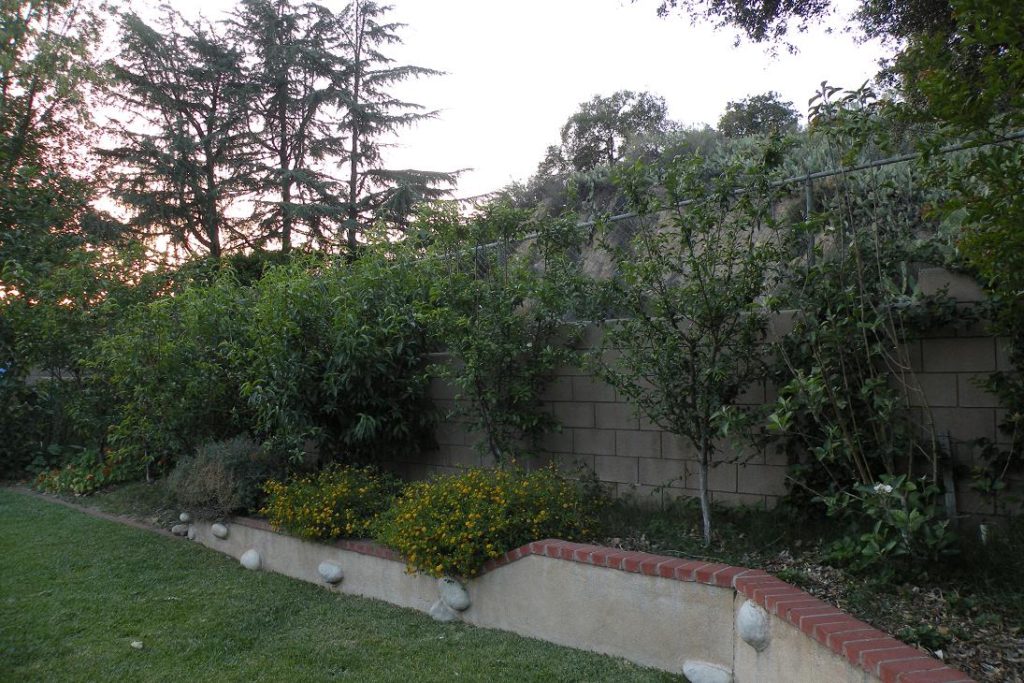
You can plant them even closer, like a foot or two apart, and grow them as if they are a two-trunked single tree.
Second, you can buy a multi-graft tree, a tree that has more than one pluot variety on its rootstock. All multi-graft trees should have the right varieties for proper pollination.
A third, more effortful option does exist, and that is grafting a pollenizer branch into your pluot tree. I did this on my Dapple Dandy by grafting in a branch of Burgundy plum. (See more about that in my post, “Grafting a pollenizer branch into your fruit tree.”)
How to know which variety pollenizes another? Tags on fruit trees at the nursery should have this information. For example, here are the tags that came with my Flavor Grenade pluot tree:
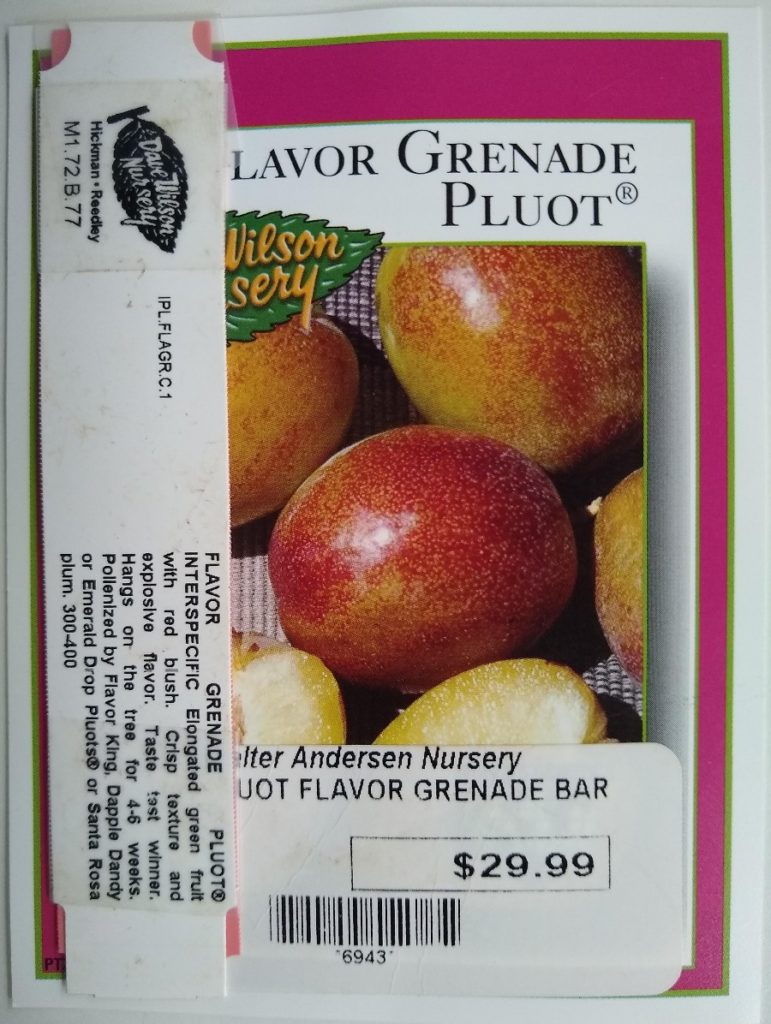
The information is also available on the Dave Wilson Nursery website, on the page for each individual variety.
Chill requirements
The other characteristic of pluots that might make growing one a challenge for you is that they perform best in inland Southern California locations, where winters are relatively chilly. My pluots perform well most years; I am twenty miles from the ocean, in the foothills of San Diego County, in Sunset Zone 20.
I’ve seen other pluot trees look good and fruit well in similar locations, such as Pomona, in Los Angeles County.
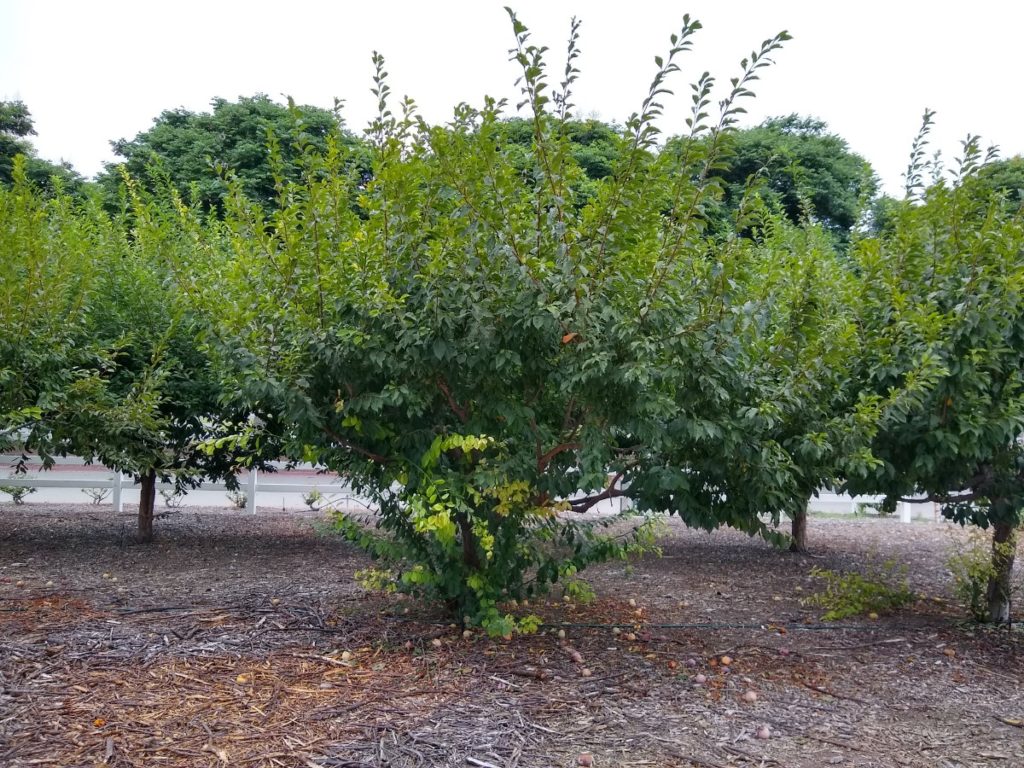
But closer to the beach or where the winter nights aren’t as cold, I have noticed some pluots not performing quite as well. Also, in the peculiarly warm and dry winter of 2017-2018, my own pluots didn’t set much fruit. (See my post, “Effects of a warm and wacky winter on deciduous fruit trees.”)
Dave Wilson Nursery has chill-hour ratings for all of the pluot varieties that they sell. And they recommend four as “low chill,” meaning these varieties should perform well in yards that get less than 500 chill hours (which describes all of Southern California within around ten miles of the ocean). These four are Emerald Drop, Splash, Flavor Grenade, and Flavor King.
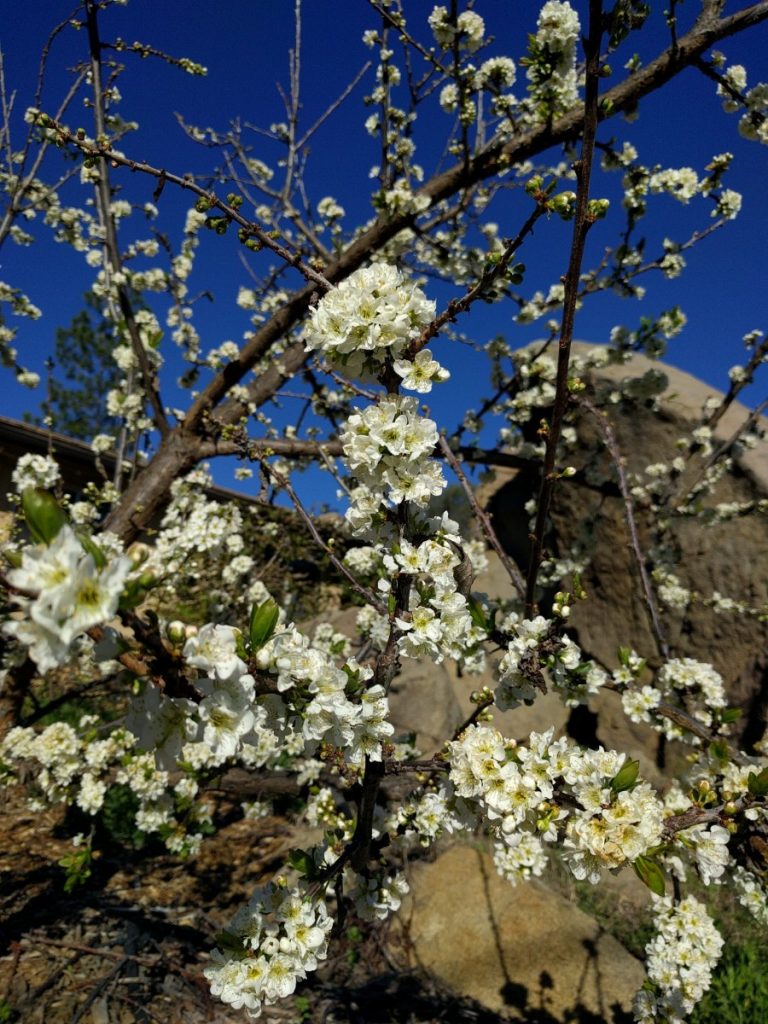
Pruning and pluot tree care
As pluots look and act like plum trees, you can prune them and otherwise treat them as such. I’ve seen no behavioral differences between pluot trees compared to plum trees on the whole, although certain varieties do have quirks. Flavor King is not as fast growing as others, for instance.
See my posts about pruning deciduous fruit trees generally for help on pruning pluots.
When and where to buy pluot trees
Also in common with other deciduous fruit trees, the best time to buy and plant a pluot is in the winter when you can buy them bare root. Good nurseries get bare-root fruit trees in usually just after Christmas. (See my post, “Bare root season is here!”)
Some nurseries put their bare-root fruit trees into containers instead of selling them bare root, unfortunately. Nevertheless, winter is the best time for buying and planting a pluot — bare root or not.
Now, fall, is the time to decide whether a pluot tree is right for your yard. If it is, beware: I started with one and now have four, and may need more.
You might also like to read:
Messages from your deciduous fruit trees after the chilly winter
Fruit tree varieties for a year-round harvest in Southern California
All of my Yard Posts are listed HERE

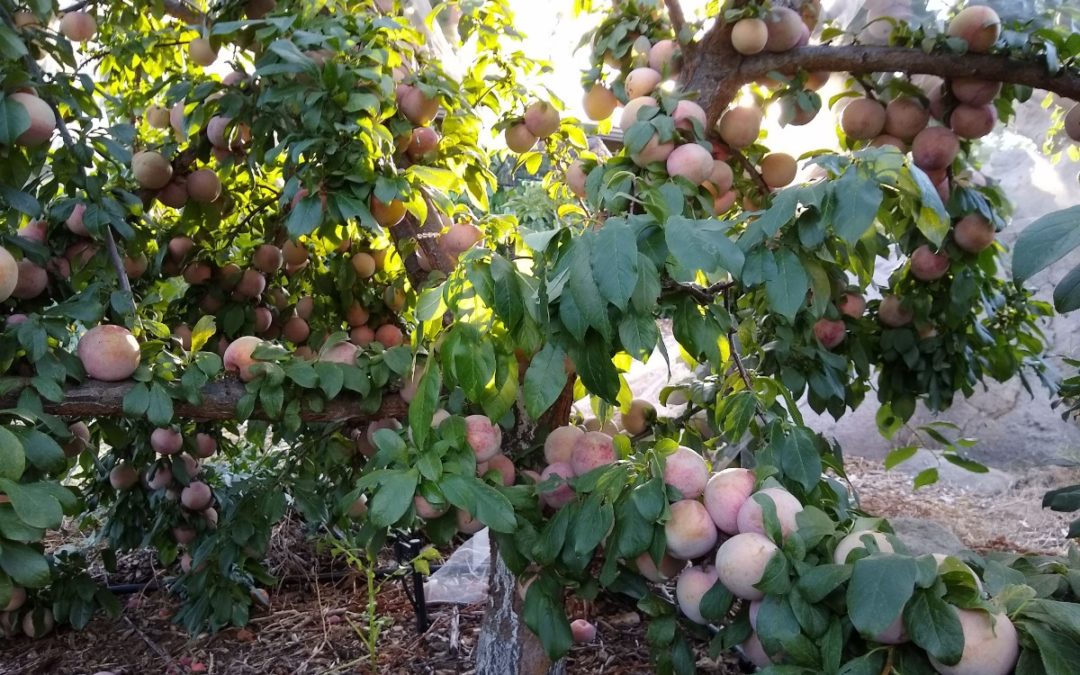

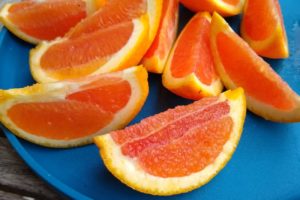
I ate one of your Dapple Dandys this afternoon, and loved it! The firm texture, but sweet taste made it a winner. Thank you!!!
Good to hear you liked it too!
Beautiful trees. Any dwarf varieties that can be grown in pots??
Thanks! I don’t know of any truly dwarf pluot varieties, but some are smaller than others. Flavor King is a naturally smaller one.
Could it thrive in a pot? Don’t know, but I’d guess it could do OK in a 24-inch box long term, based on other similar trees I’ve seen grown like that.
Keep your eyes open at Home Depot or Lowe’s when their bare root fruit trees start arriving. I bought an ultra dwart Flavor King pluot at Home Depot, after Christmas in 2020. I have it in a pot and it’s putting off blooms like crazy now – in November. I live in in coastal Santa Barbara Co., and am not thinking I’ll have much success, since they shouldn’t be blooming now. I’m taking off the blooms, hoping for the best down the line! ;-(
Hi Greg! My Flavor Grenade at 2 years old had to be hard thinned numerous times and still was loaded with fruit which we really enjoyed. My biggest challenge was the sparrows pecking them, which I have to get better at preventing. Burgundy plum as pollinator. At prior home we had GeoPride, Splash, Emerald Drop multi-graft, and we only liked the Splash, which I’m thinking of grafting this onto plum or pluot tree. cSD/San Carlos area.
The flavor kings taste how every plum should taste. Very sweet and deep purple plum tasting. Its better than any other plum or pluot I have ever eaten.
I have a Flavor King, along with a Elephant Heart Plum and a Santa Rosa Plum. The Flavor King was planted in the spring of 2018 and flowered but did not set any fruit the first season. This spring, it was loaded with flowers and I ended up with 7 fruits. They were delicious. Tasted more like a plum, but with a hint of apricot. It’s on the smaller size, probably about 6 feet tall right now. Definitely considering getting another one or another variety.
Hi Greg! Your pluots look amazing! I just planted Flavor King, Flavor Granade, Splash, Dapple Dandy (thanks to your recommendations!) and Flavor Finale pluots and was planning on polinizing them with a Santa Rosa plum I have. Do you think I need a Burgundy plum as well for pollination? Thanks for all your helpful information. Danielle
Hi Danielle,
Thanks! I don’t have a Santa Rosa plum, but everything I’ve read and heard makes me think you should get good pollination of those pluots with it alone. Ooh, those pluots are going to taste good!
Danielle/Greg,
I just scored the same four trees based on Greg’s post (Splash, Flavor King, Dapple Dandy, Flavor Grenade) plus a Flavor Supreme for earlier fruiting. Santa Rosa Plum going in the middle of the pentagon of Pluots. If the Flavor Supreme fruits for me (it needs a little more chill hours than the others), I should have Pluots to eat from about June through September. I cannot wait!
/Dave
David, you are making me look forward to summer! Most of my pluots are having a lighter year than last year (2019), but there’s still fruit, and I’m looking forward to them more than anything else in the yard.
Hi Greg,
Did you get a massive fruit set of Pluots this year too? I can’t believe how much fruit my 6 Pluot trees are all growing this year… I even got a nice large crop on the Flavor Supreme, which gave me nothing last year – can’t wait to try them. The Flavor King is also flush with young fruit, and the Flavor Grenade is so full I have to cull it and/or support the branches, they are already straining.
My three Nectaplums are also full of young fruit. What a winter for deciduous fruit trees, eh?
Thanks as always for all the great advice.
/Dave
Yes, Dave! I just thinned fruit on my couple of pluot trees, which have set nice crops. Great to hear that yours have too. This has been a wonderful winter for deciduous fruit trees, and now I’m really looking forward to eating pluots this summer. They are my favorite stone fruit.
Greg,
Love your blog and all your posts. Thanks so much for all this great info! Just want to be sure I’m reading this right. If I get two pluots of the same variety and plant them close together, I should have enough pollination right?
Thanks,
Casey
Hi Casey,
Thanks. No, you need two pluots of different varieties. For example, you can plant Geo Pride and Flavor Supreme near each other.
If you look at any of these varieties on the Dave Wilson website, you will find suggestions of varieties to use as pollenizers. For example, here is the page for Flavor Supreme: https://www.davewilson.com/product-information/product/flavor-supreme-pluot-interspecific-plum
It says you can use Geo Pride as a pollenizer. And if you look at the Geo Pride page, you’ll find that it is also said to be pollenized by Flavor Supreme. So that would be a perfect and complete pair, in terms of pollination.
(What is also nice about this pair is that the two varieties have offset harvest seasons.)
Hi Greg,
I live in Temecula and have grown pluots for years. I currently have Splash, Flavor Grenade, and Dapple Dandy, having Flavor Queen in the past. This year my Dapply Dandy has bruising on most fruit. It is not when I would expect for sun damage, and haven’t had sun damage in the past. It starts on the skin and moves inward. The core is not damaged, and most of that fruit is edible and correctly flavored. I’ve done a bit of online looking but am still clueless. Any ideas?
Hi Debbie,
A few questions: Does it occur where the fruit touches a branch or another fruit? Does it occur while on the tree or once you pick the fruit? Is there any skin damage (tearing) where the bruising occurs?
Thank you for your post. I just moved into a place that got a small but not tiny yard that already has an orange tree, mango tree, a lime tree, and a Sweet Limes Lima Dulce tree. After reading your post I really really want to plant a Flavor King tree… My family think I’m crazy but I think we have room for one more small tree. Anyway, after reading that I can plant 2 of them together and grow them as a single tree, you really give me hope! I want to plant them this winter but I’m not sure what should be my 2nd tree. Can you give me some recommendation? I considered Dapple Dandy but it’s too big… Can I keep Flavor Grenade small like Flavor King (but it’s not on Flavor King’s Pollination list but Flavor King is on its’ list…)? How about Splash Pluto (but it’s not on the Pollination list either…)? It’s obvious I’m confused. Thanks a lot in advance.
Hi YC,
I understand your confusion. I wish Dave Wilson would put out clearer pluot pollination combinations. If I were you, I would plant Flavor King with Dapple Dandy to be sure of high fruit production. At this time, I have no firsthand evidence that other pluots pollenize Flavor King, unfortunately (although the Dave Wilson listing says that Flavor Supreme pollenizes Flavor King).
Dapple Dandy is more vigorous than Flavor King, but you can easily keep it down to size by pruning. On the other hand, you could use Burgundy plum as your pollenizer. Burgundy plum is less vigorous than Dapple Dandy and it has the advantage of ripening before Flavor King so you would get fruit for a longer period with that combination. Burgundy is one of my favorite plums.
Flavor Grenade is also less vigorous than Dapple Dandy, but I can’t say with certainty how well it pollenizes Flavor King. I have Flavor Grenade near my Flavor King, but I’ve never had only those two without the Dapple Dandy so I just don’t know.
Hi, i live in California zone 10b. I had my pluot tree for less than one year and it’s starting to bloom already (it’s only the beginning of November). What does that mean? Will the fruits not survive throughout the winter?
Hi Annie,
You probably won’t get fruit from these flowers, but hopefully you’ll have another, normal, bloom in spring. See my recent post: https://gregalder.com/yardposts/fruit-trees-can-bloom-after-stress/
I’m thinking of planting some type of pluot. Do you have any suggestions for what might do well in Burbank, CA? Also where is a good place to buy? Thank you!
Hi Michael,
In Burbank you should be able to grow any variety that is rated to need 400 or fewer chill hours. There are many to choose from. See the Dave Wilson site: https://www.davewilson.com/
As for where to buy, you might be too late this year. I would plan for planting bare-root trees next winter. But you could inquire at the Armstrong in Glendale if they could still get any trees for you.
? The Dave Wilson harvest chart link is broken
I did find this one:
https://www.google.com/search?q=pluot+harvest+chart&rlz=1CDGOYI_enUS840US851&oq=pluot+harvest+chart&aqs=chrome..69i57.12126j0j4&hl=en-US&sourceid=chrome-mobile&ie=UTF-8#imgrc=sYwAY15DoSRPiM
Thanks for the heads up, Nathalie. It seems Dave Wilson recently changed a bunch of its URLs so I’ve updated them all.
Hi Greg,
What color do your pluot tree leaves turn in the fall? I’m interested in planting Flavor Grenade and Dapple Dandy and hope that their leaves turn different colors from each other. Trying to go for a beautiful fall foliage display in addition to providing tasty fruit!
Also, is it sufficient for the pluot trees to only get full sun in the summer but part sun in the winter?
Thanks!
Pluots are my absolute favorite. I have two multi grafts. One I planted in 2017 that has flavor supreme, dapple dandy, flavor queen and flavor king. Of those 4, hands down flavor king! Ive just never ate anything like it, it’s hard to beat. But I get the most fruit from my flavor supreme. But I like that one as well, the tangy taste of that one is pleasing to me and it makes for an awesome pluot jam! I prune the tree twice, to manage the size cause it grows like crazy. I just planted another in Jan 2021 that is Splash, geo pride and flavor grenade. It’s flush with blossoms right now so hopeful to taste some of them this summer. I have many other Dave Wilson trees, sorta doubled down on home growing during the pandemic. Now up to 27 fruiting trees/shrubs on .25 acres in zone 9b Sacramento CA, with the idea of year around fruiting. Always enjoy your content Greg!!
Hi Kevin,
I’ll say you doubled down! That’s a delicious yard you’ve got. Thanks for the report on your pluots.
It’s a pity…
Since I’m started to follow you on yardposts, I planted a lot of trees down here in south Portugal.
Avos from Spain, Stella cherries from Germany, I even found Snow Queen nectarines by accident at our local nursery.
But Pluots aren´t easy to come by in Europe. You once gave me the Brokaw tip for avos, do you know of any source for Pluots?
Thanks.
Something ate all of the leaves off my pluot tree but left the leaf stems. It did not affect my apple, fig, apricot or my neighbor’s plum trees.
What is this and how do I treat it?